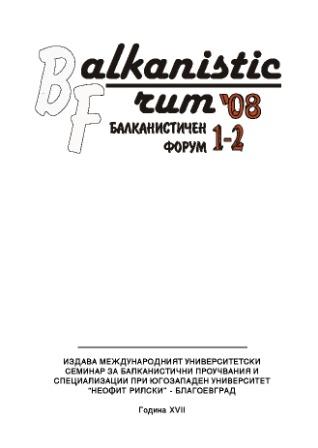
We kindly inform you that, as long as the subject affiliation of our 300.000+ articles is in progress, you might get unsufficient or no results on your third level or second level search. In this case, please broaden your search criteria.


The article analyzes the social and psychological nature of the Homo Scribens of the Bulgarian Revival (XVIII-XIX century). The second part of the XIX-th century is at the center of my research but part of the Pre Revival period has also been analyzed. The self narratives of Konstantin of Preslaw, Paisij Hilendarsky, the priest Puncho from the village of Mokresh, Emanuil Vaskidovich, Neophyte Bozvely, Neophyte of Rila, Vasil Aprilov, Petko Slavejkov, Ivan Bogorov, Onuphrij Popovich, Ilija Blaskov, Nikola Kozlev, Sava Dobroplodny, and others have been commented. I directed my attention to the theoretical literature ideas about (auto)biography; to the ways both the proto biographies and the autobiographies of the Revival intellectuals influenced the modeling of the Revival social images about what a life trajectory and self narrative should be. The following basic thesises have been commented and argued for: 1/ The writing practice and the ideas about writing in the XIX century reflect the coexistence of the Middle Age and Modernity features. The Coexistence could be noted in the writings of all intellectuals, in the economic and social features of the Homo Scribens of the Revival. 2/ The literature public space was formed comparatively lately - about the middle of the XIX-th century. Its most dynamic zones were based on the social benefits of the content of the hand written/printed literature, not on the figure of the author. "The populare poet" was figured as a responder to the social expectations, distancing in this way the Revival author form his modern identity. 3/ The profession of the writer was not a prestigious one since it could not provide sufficient incomes. Most often writing was not a basic occupation. The features of the social background determine the immaturity of the modern author identity. 4/ In the self narratives the Homo Scribens used the language clichés of the Pre Modernity. The self gestures were scattered around in marginal notes, prefaces, afterwards, memoirs, and diaries. As a form of self expression the autobiography was not popular. Its features were strongly influenced by the non literature ideas about what a autobiographical trajectory and biographical narrative should be.
More...



The report presents the general "sounding", the dominating tone in light women confessions before the police. The "sounding", the tone of these confessions is predominantly autobiographical. On the basis of all these autobiographical elements from the confessions as well as on the basis of the photos attached to the police files, the authors attempt to form a complex typology (ethno-psychological and socio-economic) of women practising the "most ancient job" in the Bulgarian Kingdom between the two world wars. The researched police statements do not only show the general characteristics of authorized prostitutes but they also reveal their many-sided individuality which is mediocre at times while at others more high-minded and claiming modernity and progressiveness going ahead of the time and the epoch. This many-sidedness can not be shown within the limits of a single report, but the authors have tried to "garnish" the arid typologization with some interesting, specific peculiarities in the police reports of the target group presented in the report.
More...

This paper examines “An Autobiography of a Bulgarian Woman” – unpublished, but kept in her archive fund, life narrative of Sonia Kraeva-Kikimenova (1892-1985). She was a Bulgarian intellectual, journalist, translator and teacher, member of a lot feminist and pacifist societies. The analyses of the autobiography is done into four levels. Because of its wide documental base the autobiography is a valuable source for events and processes in Bulgarian history. It is among a few memoirs of Bulgarian women after the Liberation (1878) where besides the national narrative authors have concentrated on their own female personality and gender identity.
More...
Some of the most popular Bulgarian saints’ cults are inherited from the Early Middle ages. But in spite of this, there are several persons who are supposed to have been honoured as saints, but we do not have any certain evidences about this. One of these men is Enravota – a Bulgarian prince, and the eldest son of the Bulgarian ruler Omurtag. In striving for proving that Enravota is a Bulgarian saint from the ninth century many pages have been written, but it should not be forgotten that the problem is ideological not archeological or literary one. We should take into consideration the situation, in which the saint’s cult appeared, and the possible obstacles and stimulus, when we try to prove the presence of it.
More...
The article treats the development of medical media discourse connected with sterility, pregnancy, birth and baby care problems of the early 20th c. The new culture, based on medical knowledge and opposed to traditional customs, has been presented on the basis of articles from popular medical magazines and newspapers in which women have been called to trust the professional assistance of doctors and maternity nurses instead of trusting to the midwives’ help – Údangerous” in most of the cases. That inevitably affects the town life where the new modernization processes influence the constructing of socio-cultural male and female roles in the Bulgarian society after the Liberation. In this “struggle” of the medical authorities with the tradition followed by women, more often men are presented as more progressive, advanced and polite. This circumstance reveals the public views on naturally predetermined differences. On the other hand, used materials unambiguously show that young (and educated) generation accepts novelty when it is necessary, but do not forget tradition that has been handed down and remembered up to the present.
More...